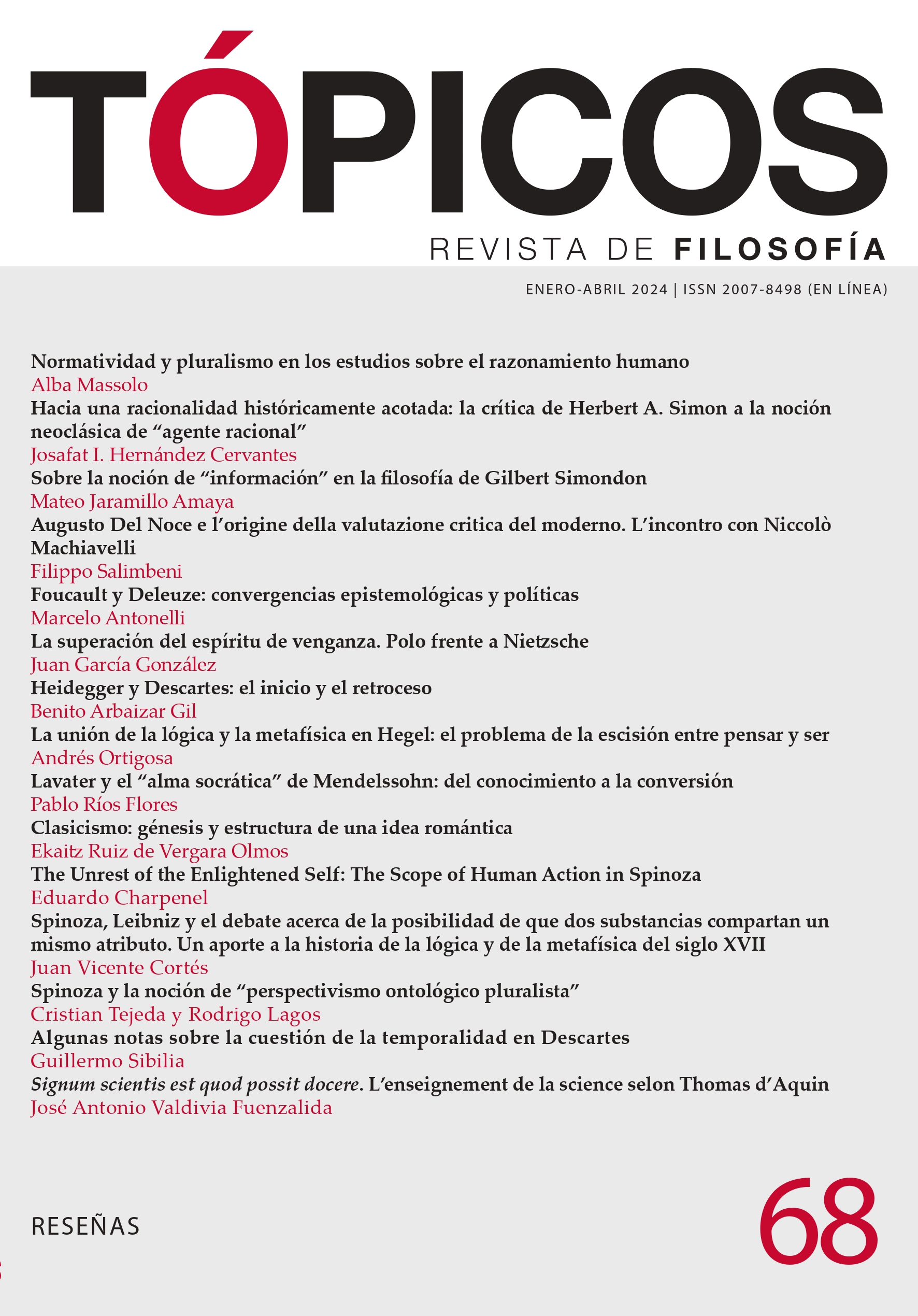Mendelssohn’s “Socratic Soul” and Lavater: From Knowledge to Conversion
Pubblicato 2023-12-07
Parole chiave
Come citare
Copyright (c) 2023 Tópicos, Revista de Filosofía

Questo lavoro è fornito con la licenza Creative Commons Attribuzione - Non commerciale - Non opere derivate 4.0 Internazionale.
Downloads
Altmetrics
Citas
Abstract
El 25 de agosto de 1769, Johann Caspar Lavater envió a Moses Mendelssohn una dedicatoria junto con la traducción de algunas secciones de La palingénésie philosophique, de Charles Bonnet. En esta dedicatoria, Lavater desafió a Mendelssohn a refutar públicamente los argumentos de Bonnet sobre la verdad del cristianismo o, en caso contrario, “hacer lo que Sócrates habría hecho si hubiera leído esta obra y la hubiera encontrado irrefutable”. En su réplica a Lavater, Mendelssohn interpreta este desafío como un llamado a la conversión. El objetivo del presente artículo es analizar el modo en que los ideales de conocimiento y evidencia de Lavater están inextricablemente unidos a su celo misionero.
Riferimenti bibliografici
- Abbt, T. y Mendelssohn, M. (2018). Exchange on the Vocation of Man. The 287th Letter Concerning the Latest Literature. A. Pollok (ed. y trad.). Graduate Faculty Philosophy Journal, 39(1), 237-261. DOI: https://doi.org/10.5840/gfpj20183919.
- Altmann, A. (1973). Turning Point: The Lavater Affair. En A. Altmann, Moses Mendelssohn: A Biographical Study. (pp. 194-263). University of Alabama Press.
- Blumenberg, H. (2018). Paradigmas para una metaforología. J. Pérez de Tudela Velasco (trad.). Trotta.
- Bonnet, C. (1769a). La palingénésie philosophique, ou Idées sur l’état passé et sur l’état futur des êtres vivants. I. [Part. I-XI]. Claude Philibert et Barthelemi Chirol.
- Bonnet, C. (1769b). La palingénésie philosophique, ou Idées sur l’état passé et sur l’état futur des êtres vivants. II. [Part. XII-XXII]. Claude Philibert et Barthelemi Chirol.
- Bonnet, C. (1986). Bonnet to Needham, 8 July 1769. En R. G. Mazzolini y S. A. Roe (eds.), Science Against the Unbelievers: The Correspondence of Bonnet and Needham, 1760-1780. (pp. 271-272). University of Oxford.
- Bourel, D. (2004). Moses Mendelssohn. La naissance du judaïsme moderne. Gallimard.
- Carlsson, E. (2016). Eighteenth-Century Neology. En U. L. Lehner, R. A. Muller y A. G. Roeber (eds.), The Oxford Handbook of Early Modern Theology, 1600-1800. (pp. 642-650). Oxford Univerity Press.
- Cassirer, E. (2016). Filosofía de las formas simbólicas. I. El lenguaje. A. Morones (trad.). FCE.
- Feiner, S. (2010). Affront and Sickness: The Lavater Affair. En S. Feiner, Moses Mendelssohn: Sage of Modernity. (pp. 83-106). A. Berris (trad.). Yale University Press,
- Freedman, J. (2002). A Poisoned Chalice. Princeton University Press.
- Goetschel, W. (2004). Staking Out Grounds for Public Reason: Lavater’s Challenge. En W. Goetschel, Spinoza’s Modernity: Mendelssohn, Lessing, and Heine. (pp. 119-132). The University of Wisconsin Press.
- Hochman, L. (2014). Reading Faces, Reading Souls. Johann Caspar Lavater’s New Physiognomy. En L. Hochman, The Ugliness of Moses Mendelssohn: Aesthetics, Religion, and Morality in the Eighteenth Century. (pp. 104-144). Routledge.
- Kohler, D. (2015). Eschatologie und Soteriologie in der Dichtung. Johann Caspar Lavater im Wettstreit mit Klopstock und Herder. De Gruyter.
- Koselleck, R. (2012). Sobre la estructura antropológica y semántica de Bildung. En R. Koselleck, Historia de conceptos. Estudios sobre semántica y pragmática del lenguaje político y social. (pp. 49-93). L. F. Torres (trad.). Trotta.
- Lavater, J. C. (1769). Christliches Handbüchlein oder ausserlesene Stelle der heiligen Schrift mit Versen begleitet. I. Gustrow.
- Lavater, J. C. (1772). Von der Physiognomik. Weidmanns Erben und Reich.
- Lavater, J. C. (1775). Physiognomische Fragmente zur Beförderung der Menschenkenntniß und Menschenliebe. I. Weidman, Erben und Reich-Heinrich Steiner und Compagnie.
- Lavater, J. C. (1776). Physiognomische Fragmente zur Beförderung der Menschenkenntniß und Menschenliebe. II. Weidman, Erben, und Reich-Heinrich Steiner und Compagnie.
- Lavater, J. C. (1778). Physiognomische Fragmente zur Beförderung der Menschenkenntniß und Menschenliebe. IV. Erben, und Reich; Heinrich Steiner und Compagnie.
- Lavater, J. C. (1974). Widmung an Moses Mendelssohn. En M. Mendelssohn, Gesammelte Schriften. Jubiläumsausgabe. Band 7. Schriften zum Judentum. I. (p. 3). S. Rawidowicz (ed.). Friedrich Frommann.
- Leonard, M. (2012). Socrates and the Reason of Judaism: Moses Mendelssohn and Immanuel Kant. En M. Leonard, Socrates and the Jews: Hellenism and Hebraism from Moses Mendelssohn to Sigmund Freud. (pp. 17-64). University of Chicago Press.
- Luginbühl-Weber, G. (1994). “…zu thun, …was Sokrates gethan hätte”: Lavater, Mendelssohn und Bonnet über die Unsterblichkeit. En K. Pestalozzi y H. Weigelt (eds.), Das Antlitz Gottes im Antlitz des Menschen. Zugänge zu Johann Kaspar Lavater. (pp. 114-148). Vandenhoeck & Ruprecht.
- Mazzolini, R. G. y Roe, S. A. (1986). Introduction. En R. G. Mazzolini y S. A. Roe (eds.), Science Against the Unbelievers: The Correspondence of Bonnet and Needham, 1760-1780. (pp. 1-170). University of Oxford.
- Mendelssohn, M. (1974). Gesammelte Schriften. Jubiläumsausgabe. Band 7. Schriften zum Judentum. I. S. Rawidowicz (ed.). Friedrich Frommann.
- Mendelssohn, M. (1991). Gesammelte Schriften. Jubiläumsausgabe. Band 5.1. Rezensionsartikel in “Briefe, die neueste Literatur betreffend“ (1759–1765). E. J. Engel (ed.). Friedrich Frommann.
- Mendelssohn, M. (2006). Fedón o sobre la inmortalidad del alma. J. Monter (trad.). MuVIM.
- Rieppel, O. (1988) The Reception of Leibniz’s Philosophy in the Writings of Charles Bonnet (1720-1793). Journal of the History of Biology, 21(1), 119-145.
- Mendelssohn, M. (2011). The Problem of Change. En O. Rieppel, Evolutionary Theory and the Creation Controversy. (pp. 11-26). Springer.
- Stoichita, V. I. (1997). Johann Caspar Lavater’s “Essays on Physiognomy” and the Hermeneutics of Shadow. A.-M. Glasheen (trad.). RES: Anthropology and Aesthetics, 31, 128-138.
- Sukiennicka, M. (2017). La Palingénésie philosophique de Charles Bonnet : le pouvoir heuristique d’un imaginaire matérialiste des Lumières. Studia Romanica Posnaniensia, 44(4), 25-34. DOI: https://doi.org/10.14746/strop.2017.444.002.
- Tomasoni, F. (2003). “True” Religion and Positive Religions: Mendelssohn and Lavater. En F. Tomasoni, Modernity and the Final Aim of History: The Debate over Judaism from Kant to the Young Hegelians. (pp. 18-32). Kluwer Academic.
- Zac, S. (1983). La querelle Mendelssohn-Lavater. Archives de Philosophie, 46(2), 219-254.





